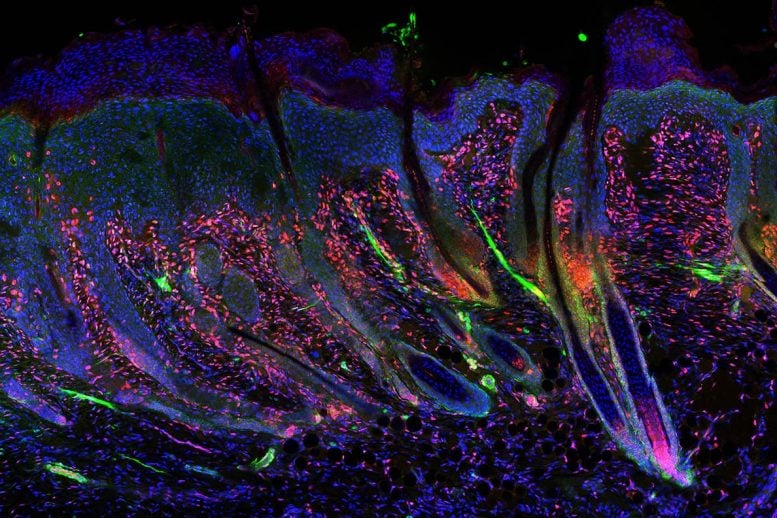
A newly identified genetic factor allows adult skin to repair itself like the skin of a newborn babe. The discovery by Washington State University researchers has implications for better skin wound treatment as well as preventing some of the aging process in skin.
In a study, published in the journal eLife on September 29, 2020, the researchers identified a factor that acts like a molecular switch in the skin of baby mice that controls the formation of hair follicles as they develop during the first week of life. The switch is mostly turned off after skin forms and remains off in adult tissue. When it was activated in specialized cells in adult mice, their skin was able to heal wounds without scarring. The reformed skin even included fur and could make goosebumps, an ability that is lost in adult human scars.
“We were able to take the innate ability of young, neonatal skin to regenerate and transfer that ability to old skin,” said Ryan Driskell, an assistant professor in WSU’s School of Molecular Biosciences. “We have shown in principle that this kind of regeneration is possible.”
Mammals are not known for their regenerative abilities compared to other organisms, such as salamanders that can regrow entire limbs and regenerate their skin. The WSU study suggests that the secret to human regeneration might be found by studying our own early development.
“We can still look to other organisms for inspiration, but we can also learn about regeneration by looking at ourselves,” said Driskell. “We do generate new tissue, once in our life, as we are growing.”
Driskell’s team used a new technique called single cell RNA sequencing to compare genes and cells in developing and adult skin. In developing skin, they found a transcription factor–proteins that bind to DNA and can influence whether genes are turned on or off. The factor the researchers identified, called Lef1, was associated with papillary fibroblasts which are developing cells in the papillary dermis, a layer of skin just below the surface that gives skin its tension and youthful appearance.
When the WSU researchers activated the Lef1 factor in specialized compartments of adult mouse skin, it enhanced the skins’ ability to regenerate wounds with reduced scarring, even growing new hair follicles that could make goosebumps.
Driskell first got the idea to look at early stages of mammalian life for the capacity to repair skin after learning of the work of Dr. Michael Longaker of Stanford University. When performing emergency life-saving surgery in utero, Longaker and his colleagues observed that when those babies were born they did not have any scars from the surgery.
A lot of work still needs to be done before this latest discovery in mice can be applied to human skin, Driskell said, but this is a foundational advance. With the support from a new grant from the National Institutes of Health, the WSU research team will continue working to understand how Lef1 and other factors work to repair skin. Also to help further this research, the Driskell lab has created an open, searchable web resource for the RNA sequence data for other scientists to access at skinregeneration.org.
Reference: “Lef1 expression in fibroblasts maintains developmental potential in adult skin to regenerate wounds” by Quan M Phan, Gracelyn M Fine, Lucia Salz, Gerardo G Herrera, Ben Wildman, Iwona M Driskell and Ryan R Driskell, 29 September 2020, eLife.
DOI: 10.7554/eLife.60066
Never miss a breakthrough: Join the SciTechDaily newsletter.
10 Comments
If scientists continue these developments and they prove effective in humans They will probably price them so high that only the ultra rich can afford them.
Until economics (if allowed to operate) push the price down…
Personally my skin’s external appearance doesn’t concern me much.
I hope someday this can lead to routine gum tissue regeneration procedures.
Amazing what the future can hold for future generations. I do wish that things like this that are discovered with “grants” could be available to more people.
Aging is a natural process and the thought of accidentally dating someone only to find out that is old enough to be a great grandparent who still subject to sudden age related death by heart attack, stroke, etc. is just creepy. How about thinking more in terms of burn victims, deep wounds, etc. that even with skin grafts (along with rejection issues) often still have serious scarring.
Scientists don’t set prices. Even if somebody patented a related process, patents expire fairly quickly. Regeneration could greatly extend potential lifespan if it works with other human tissue.
“Vanity” treatments usually have applications for diseases and disorders and vis versa. Any resources spent on research can have unknown assistive effects elsewhere. Crispr was discovered while looking for how bacteria passed on their virus immunity to future generations. Research into hair regrowth and scar healing may lead to break throughs in tissue regeneration. [full discloser, this comment was made by a man with undesired thinning hair…]
I have for the last 41 years Recieved IVIG and I have many Secrets of the advantages from getting IVIG or Antibodies.41 years I look nothing like others my age is my first hint. I am currently writing a Book as to why for 41 years I have Recieved Antibodies and the advantages.
Write your book.
Make more since if they allow it to the public it’s the general people that do all the physical work those we the ones that should get it to continue the working middle class effectively making it affordable for everyone and those who created the tech would be legends